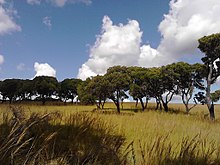Uapaca bojeri
| Uapaca bojeri | |
|---|---|
 |
|
| Scientific classification | |
| Kingdom: | Plantae |
| Clade: | Angiosperms |
| Clade: | Eudicots |
| Clade: | Rosids |
| Order: | Malpighiales |
| Family: | Phyllanthaceae |
| Genus: | Uapaca |
| Species: | U. bojeri |
| Binomial name | |
|
Uapaca bojeri Baill., 1874 |
|
| Synonyms | |
|
Uapaca clusiacea Baker |
|
Uapaca clusiacea Baker
Tapia (Malagasy pronunciation: ta-pee), Uapaca bojeri, is a tree species endemic to Madagascar. A characteristic element of the Madagascan flora, it occurs in the central highlands, where it dominates a type of sclerophyllous forest or woodland. Tapia forest has a high ecological value due to the fauna and flora it harbours, and is of economic interest to the local population, e.g. for collection of tapia fruits, firewood, mushrooms or wild silkworms, and hunting. Its original extent has probably diminished, but the local impact through fire and cutting is also seen as a form of sustainable use.
Tapia is a tree that can grow 10–12 metres (33–39 ft) high, but usually stays at 3–5 metres (9.8–16.4 ft). Leaves are alternate and sclerophyllous. The bark is thick and furrowed. The tree is monoecious; its flowers appear from March to September. Male flowers have five stamens and five tepals, and are clustered in dense balls with an involucre of 7–8 bracts. Female inflorescences are reduced to one flower with a trilocular ovary, surrounded by bracts. Fruits are drupes 2–3 centimetres (0.79–1.18 in) in diameter, green to yellow, and brown when ripe. They contain a sweet, sticky mesocarp and three seeds.
The common name "tapia" is pronounced ta-pee in Malagasy. Tapia fruits are known as voan'tapia. The species epithet of the scientific name, "bojeri", refers to the type specimen's collector, Wenceslas Bojer.
...
Wikipedia
